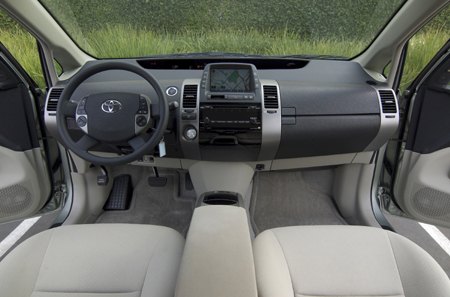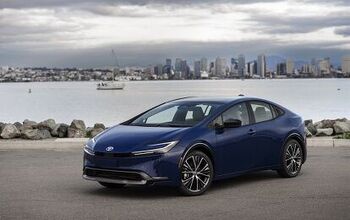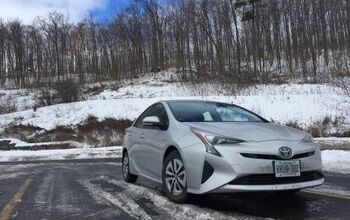Toyota Prius Review
The Toyota Prius is a technological tour-de-force. At low speeds, its 28hp nickel metal hydride battery provides propulsion. Put the hammer down, and a 1.5 litre, 76hp internal combustion engine takes over. The transition between the two systems is relatively seamless. You don't even need an extension cord; the gas engine and energy from the braking system recharge the battery. What's more, the new look gas-electric Prius hybrid exceeds California's Super Ultra Low Vehicle (SULEV) exhaust standards. Driven sensibly it gets around 45mpg (US Gallons).
Terrific! If you're a money-conscious motorist who believes SUVs and their ilk pollute the planet and pervert the course of American foreign policy, the $20K Prius is a godsend. But if you're a petrolhead who regularly sacrifices social responsibility on the altar of adrenal release, Toyota's clean, green mileage machine is a far less attractive proposition. For one thing, the design is spectacularly dull. Quite how Toyota managed to blend so many ill-conceived details (slab-sides, gruesome headlights, hideous rear hatch, etc.) into such a narcoleptic shape is a mystery almost as impenetrable Chris Bangle's justification for his "flame-surfaced" BMWs. In fact, the Prius is so unintentionally stealthy it gives drivers automotive Alzheimer's; I "lost" the car in a supermarket parking lot whilst standing directly in front of it.
For another, Toyota's single-minded pursuit of fuel efficiency compromises the Prius' ergonomics. Jump inside and slip into bus driver mode. You hold the undersized steering wheel in your lap, sitting "on" rather than "in" the seat. Blame the Prius' raised floor, lifted to accommodate the batteries and electric motor. The set-up also necessitates an ugly, visibility-killing split rear window. The elevated floor leaves reasonable cargo space – although the sloping roof limits your storage options to grocery bags, dwarf plants and short luggage.
The situation is no better up front. In an attempt to eke out the last possible mpg, the Prius' designers opted for a steeply raked front window. There are army tanks with more forward visibility. The aerodynamically efficient screen also requires huge "flying buttress" pillars to support it, which virtually eliminate peripheral vision. And, as the Prius' digital speedo, fuel gauge and gear selector live in the forward edge of the endless windscreen, the display seems a good five miles away.
The Prius' central display provides the hybrid's P.C. party trick. The computer screen constantly calculates your mpg and the amount of electric energy re-generated during braking. (It's the virtuous version of the devilish G-force meter found in the late, demented Nissan Skyline.) Tap the screen to switch to a graphic of a skeletal Prius indicating whether you're using or reclaiming battery power. The touch screen also provides audio and climate tweakery intuitive enough to make a mockery of Germany's craze for over-complicated "mouse" controllers. Unfortunately, you can't shut the damn thing off without using voice recognition (which doesn't recognize that particular sentence construction).
The Prius' champions – and they are legion – will dismiss such complaints as environmentally insensitive kvetching. The Prius is a cutting edge automobile, leading the charge towards responsible motoring. Style, visibility and toys be damned! The mileage is the thing. In that case, Toyota better hope tree huggers aren't technophobes. To start the Prius, you either activate the keyless ignition feature or slot the flat "key" into the dashboard, press the power button (avoiding the windshield wiper stalk), wait for the electronics to spool up, press the electronic parking brake button, release the "normal" parking brake pedal, keep your foot on the brake pedal, select drive with the stubby, dash-mounted joystick and… away you go. And here's where true believers and driving enthusiasts part company…
The Toyota Prius drives like most low-cost, mass market, front-wheel-drive sedans. Give the gruff-sounding four-cylinder, multi-valve engine a swift kick and The Prius ambles to 60 in 11.3 seconds. It cruises comfortably at 70 and tops out at 104mph. The computer-actuated brakes feel a bit sluggish, graunching as they regenerate battery power, but they're effective enough. The power steering is as light as a bird's femur… um… I'm sorry, what was I talking about? Suffice it to say, the gas-electric hybrid's power and handling are close enough to its petroleum-powered peers to be ignored.
So here's the deal: no matter how you thrash the Prius – flooring it at every opportunity, braking late and hard – you can't get the consumption any worse than 27mpg (US). Baby it and the Prius travels at least 40 miles for every gallon of dead dinosaur. It offers maximum fuel efficiency with reasonable real-world performance. I have no doubt that a version of Toyota's Hybrid Synergy Drive system will someday find its way into every passenger vehicle category: SUV, MPV, CUV, station wagon, sedan and, gulp, sports car. Will hybrid power make the world a safer, greener place? You tell me. Meanwhile, if you're willing to trade driving pleasure and decent ergonomics for cheap, guilt-free motoring, the Prius is the way to go.
More by Robert Farago
Latest Car Reviews
Read moreLatest Product Reviews
Read moreRecent Comments
- Arthur Dailey We have a lease coming due in October and no intention of buying the vehicle when the lease is up.Trying to decide on a replacement vehicle our preferences are the Maverick, Subaru Forester and Mazda CX-5 or CX-30.Unfortunately both the Maverick and Subaru are thin on the ground. Would prefer a Maverick with the hybrid, but the wife has 2 'must haves' those being heated seats and blind spot monitoring. That requires a factory order on the Maverick bringing Canadian price in the mid $40k range, and a delivery time of TBD. For the Subaru it looks like we would have to go up 2 trim levels to get those and that also puts it into the mid $40k range.Therefore are contemplating take another 2 or 3 year lease. Hoping that vehicle supply and prices stabilize and purchasing a hybrid or electric when that lease expires. By then we will both be retired, so that vehicle could be a 'forever car'. Any recommendations would be welcomed.
- Eric Wait! They're moving? Mexico??!!
- GrumpyOldMan All modern road vehicles have tachometers in RPM X 1000. I've often wondered if that is a nanny-state regulation to prevent drivers from confusing it with the speedometer. If so, the Ford retro gauges would appear to be illegal.
- Theflyersfan Matthew...read my mind. Those old Probe digital gauges were the best 80s digital gauges out there! (Maybe the first C4 Corvettes would match it...and then the strange Subaru XT ones - OK, the 80s had some interesting digital clusters!) I understand the "why simulate real gauges instead of installing real ones?" argument and it makes sense. On the other hand, with the total onslaught of driver's aid and information now, these screens make sense as all of that info isn't crammed into a small digital cluster between the speedo and tach. If only automakers found a way to get over the fallen over Monolith stuck on the dash design motif. Ultra low effort there guys. And I would have loved to have seen a retro-Mustang, especially Fox body, have an engine that could rev out to 8,000 rpms! You'd likely be picking out metal fragments from pretty much everywhere all weekend long.
- Analoggrotto What the hell kind of news is this?





































Comments
Join the conversation